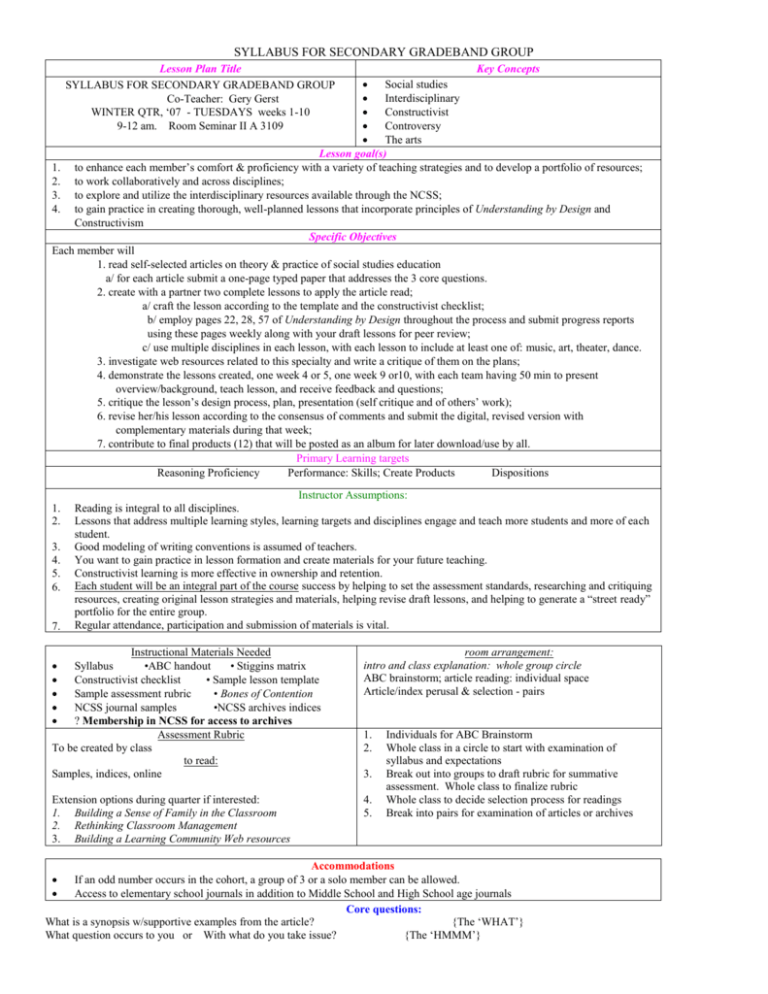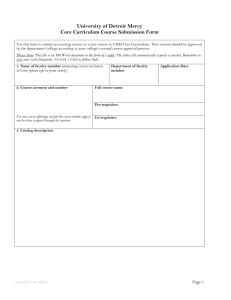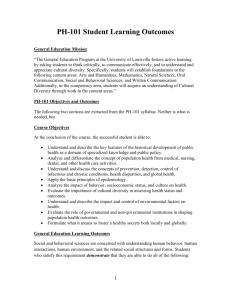Secondary Methods Syllabus (2008 Cohort)
advertisement

SYLLABUS FOR SECONDARY GRADEBAND GROUP
Lesson Plan Title
SYLLABUS FOR SECONDARY GRADEBAND GROUP
Co-Teacher: Gery Gerst
WINTER QTR, ‘07 - TUESDAYS weeks 1-10
9-12 am. Room Seminar II A 3109
Key Concepts
Social studies
Interdisciplinary
Constructivist
Controversy
The arts
Lesson goal(s)
1. to enhance each member’s comfort & proficiency with a variety of teaching strategies and to develop a portfolio of resources;
2. to work collaboratively and across disciplines;
3. to explore and utilize the interdisciplinary resources available through the NCSS;
4. to gain practice in creating thorough, well-planned lessons that incorporate principles of Understanding by Design and
Constructivism
Specific Objectives
Each member will
1. read self-selected articles on theory & practice of social studies education
a/ for each article submit a one-page typed paper that addresses the 3 core questions.
2. create with a partner two complete lessons to apply the article read;
a/ craft the lesson according to the template and the constructivist checklist;
b/ employ pages 22, 28, 57 of Understanding by Design throughout the process and submit progress reports
using these pages weekly along with your draft lessons for peer review;
c/ use multiple disciplines in each lesson, with each lesson to include at least one of: music, art, theater, dance.
3. investigate web resources related to this specialty and write a critique of them on the plans;
4. demonstrate the lessons created, one week 4 or 5, one week 9 or10, with each team having 50 min to present
overview/background, teach lesson, and receive feedback and questions;
5. critique the lesson’s design process, plan, presentation (self critique and of others’ work);
6. revise her/his lesson according to the consensus of comments and submit the digital, revised version with
complementary materials during that week;
7. contribute to final products (12) that will be posted as an album for later download/use by all.
Primary Learning targets
Reasoning Proficiency
Performance: Skills; Create Products
Dispositions
1.
2.
3.
4.
5.
6.
7.
Instructor Assumptions:
Reading is integral to all disciplines.
Lessons that address multiple learning styles, learning targets and disciplines engage and teach more students and more of each
student.
Good modeling of writing conventions is assumed of teachers.
You want to gain practice in lesson formation and create materials for your future teaching.
Constructivist learning is more effective in ownership and retention.
Each student will be an integral part of the course success by helping to set the assessment standards, researching and critiquing
resources, creating original lesson strategies and materials, helping revise draft lessons, and helping to generate a “street ready”
portfolio for the entire group.
Regular attendance, participation and submission of materials is vital.
Instructional Materials Needed
Syllabus
•ABC handout
• Stiggins matrix
Constructivist checklist
• Sample lesson template
Sample assessment rubric
• Bones of Contention
NCSS journal samples
•NCSS archives indices
? Membership in NCSS for access to archives
Assessment Rubric
To be created by class
to read:
Samples, indices, online
room arrangement:
intro and class explanation: whole group circle
ABC brainstorm; article reading: individual space
Article/index perusal & selection - pairs
Extension options during quarter if interested:
1. Building a Sense of Family in the Classroom
2. Rethinking Classroom Management
3. Building a Learning Community Web resources
4.
5.
1.
2.
3.
Individuals for ABC Brainstorm
Whole class in a circle to start with examination of
syllabus and expectations
Break out into groups to draft rubric for summative
assessment. Whole class to finalize rubric
Whole class to decide selection process for readings
Break into pairs for examination of articles or archives
Accommodations
If an odd number occurs in the cohort, a group of 3 or a solo member can be allowed.
Access to elementary school journals in addition to Middle School and High School age journals
Core questions:
What is a synopsis w/supportive examples from the article?
{The ‘WHAT’}
What question occurs to you or With what do you take issue?
{The ‘HMMM’}
SYLLABUS FOR SECONDARY GRADEBAND GROUP
What are the implications for you as teacher?
Time
- 9:25
What the teacher does:
1. THE ABC BRAINSTORM outline
topic = Social Studies
15 min
10 min
15 min
5 min
5 min
10:10-11:00
11:00-11:45
11:45-12
1.
2.
3.
4.
5.
6.
7.
1.
2.
{The ‘SO WHAT?’}
What the students do:
Pre-Assess
1. Individuals: Each does the Brainstorm on own paper;
Share summary paragraphs aloud.
Activity (include where possible the “hook”
Pass out: Bones of Contention article and direct
1. Read: Bones of Contention article / solo
students to read, then reply to core questions.
write a What, Hmm, & So What?
Solicit responses to core questions
2. Share What, Hmm, So What / circle
Pass out all syllabus/handouts/readings; explain
3. Peruse handouts / circle; Q and A
purpose
Give my email address; each send a note to
gerstg@evergreen.edu to verify class roster & for
4. Send me an email note tonight
me to save your email address
Form teams for lesson plan creation; put on roster
5. Choose your working partner for tasks
Start selection of first reading/web site for lesson
plan and choose a week.
6. Class decides how to apportion the lesson plan
Pass out sample assessment rubric; seek input to
articles / web sites; seek help from Gery; take
create standards for summative class assessment
breaks
for each student AND for rubric for lesson plan
feedback
7. Create as a class two separate rubrics
Closure plan: reinforcement/synthesis of learning, affirmations, glimpse at tomorrow-bridge
Recap of day’s and class’ goals and
Seek clarification as needed
accomplishments
Break out with partner to strategize for lesson creation
Recap of what my next duties will be, and
and/or begin reading.
students’
Formative Assessment(s) [Are they getting it?]
Core questions after Bones of Contention
Checking in with teams
Core questions papers for each article (2)
Feedback from peers/teacher on draft lessons and final presentations
Summative Assessment [Did they get it?]
Peer-created rubric:
Potentially based on criteria of reading and review, lesson plan creation per criteria, lesson demonstration, critique of peers’
lessons, timely lesson plan revision and submission, participation and attendance.
Teacher reflections/caveats for those who use this lesson:
Reading strategies and resources for content areas
http://www.readingquest.org/
Curriculum-Based Assessment Projects from OSPI for Social Studies
http://www.k12.wa.us/CurriculumInstruct/SocStudies/CBAs.aspx
National Association of Japan-America Societies
http://www.us-japan.org/other/sitemap.html <see “resources”>
Center for Civic Education
http://www.civiced.org/curriculum.php <see “sample lessons” w/ reproduceable contents>
Earth Force (Community action and problem solving)
http://www.earthforce.org/ <See Tools for Teachers, including template and rubric>
WorldWar2 history <materials for oral history, lesson ideas, online video clips; adaptable to elementary; includes links to JapaneseAmerican internment resources. Note: I have the video too>
http://www.wwiihistoryclass.com/ See also: www.densho.org
Teacher2Teacher lesson plan ideas postings
http://teacherslounge.editme.com/elemsocstud
Resources for Learning Disabilities (even for Macs)…see resources too
http://ldresources.com/
Civics lesson ideas centering around citizenship and voting
http://www.secstate.wa.gov/elections/outreach/
Online learning center of the Pilgrim settlement
http://www.plimoth.org/learn/
Old Sturbridge Village, a living early 19th Century history in Conn
http://www.osv.org/
Colonial Williamsburg
http://history.org/
Jamestown, VA, our first English settlement
http://www.virtualjamestown.org/
Documents, people, pictures, etc. on early US history
http://earlyamerica.com/
SYLLABUS FOR SECONDARY GRADEBAND GROUP
Smithsonian’s fabulous online resource for teaching
http://www.si.edu/history_and_culture/







